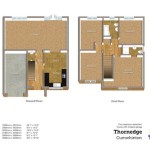Canadian House Plans on Slab: A Comprehensive Guide
Canadian house plans on slab have become increasingly popular in recent years, offering a cost-effective and modern alternative to traditional foundation methods. These homes are built directly on a concrete slab, eliminating the need for a basement or crawlspace. In this article, we will delve into the essential aspects of Canadian house plans on slab, including their advantages, disadvantages, and key design considerations.
Advantages of House Plans on Slab:
- Cost-effective: Slab foundations are typically less expensive to construct than other foundation types, resulting in significant cost savings for homeowners.
- Energy-efficient: The insulated concrete slab provides excellent insulation and thermal mass, reducing energy consumption and utility bills.
- Faster construction time: Slab foundations can be poured and cured in a shorter amount of time compared to traditional foundations, leading to a faster construction process.
- Accessibility: Homes on slab offer increased accessibility for individuals with mobility impairments or those who prefer single-level living.
Disadvantages of House Plans on Slab:
- Limited storage space: Without a basement or crawlspace, homes on slab offer less storage space compared to traditional homes.
- Potential for moisture issues: Proper drainage and waterproofing measures are crucial to prevent moisture issues in slab foundations.
- Less resilient to earthquakes: Slab foundations are less resilient to earthquakes compared to other foundation types.
Key Design Considerations for Canadian House Plans on Slab:
- Insulation: It is essential to ensure proper insulation for the concrete slab to minimize heat loss and optimize energy efficiency.
- Drainage: Adequate drainage systems should be installed around the perimeter of the slab to prevent water accumulation and potential moisture issues.
- Vapor barrier: A vapor barrier beneath the slab is crucial to prevent moisture from rising from the ground into the home.
- Expansion joints: Expansion joints are necessary to accommodate movement in the concrete slab caused by temperature changes.
When selecting Canadian house plans on slab, it is essential to consult with an experienced architect or home designer to ensure that the design meets your specific needs and preferences while considering the above-mentioned advantages and challenges.
Additional Benefits and Considerations:
- Modern designs: House plans on slab often feature contemporary and modern designs that appeal to many homeowners.
- Customization: Canadian house plans on slab can be customized to suit individual tastes and requirements.
- Compatibility with various climates: Slab foundations are suitable for most Canadian climates, although additional insulation may be required in colder regions.
In conclusion, Canadian house plans on slab offer a range of benefits, making them a popular choice for modern and cost-effective home construction. However, it is important to carefully consider the advantages and disadvantages and consult with professionals to ensure a successful and satisfactory build.

Slab Foundation House Plans Floor Drummond

Canadian House Plans Home Designs The Plan Collection

Slab Foundation House Plans Floor Drummond

Canadian House Plans Home Floor Designs The Designers

House Plans S Building Centre Timber Mart

House Plans With Slab Foundation

Slab Floor Plans

House Plans S Building Centre Timber Mart

Canadian House Plans Home Floor Designs The Designers

House Plans With Slab Foundation








